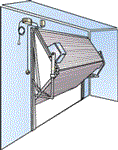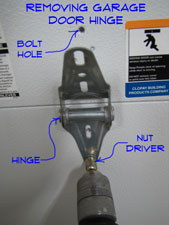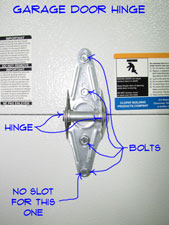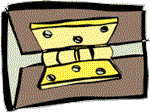Doors
Garage Door Opener Problems
 What can cause you to have garage door opener problems? Your garage door opener is both an electrical and mechanical device. It has moving parts that can break or need lubrication.
What can cause you to have garage door opener problems? Your garage door opener is both an electrical and mechanical device. It has moving parts that can break or need lubrication.
There are (1) Steps in this series. (1) 'Checking Garage Door Sensors', a safety feature on all newer door openers. (2) 'Fixing Your Garage Door Remote' covers issues with the remote. (3) 'Adjusting the Limit Switches', making sure the door closes all the way. (4) 'Door Closing Issues' and (5) 'Replacing a Garage Door Opener' are the last two topics.
Factor in the electrical and safety features and you can have a choice of problems. Can you fix them? Most of the time the answer is yes. Will it be hard? Well,,, sometimes.
Your garage door opener cannot lift the door without the springs. If a spring is broken you have a different problem. There are many things that can go wrong that are not difficult to fix. A few simple tools and a little patience and you are all set.
The information that follows will give you the insight you need or the resources to deal with your garage door opener. Use the evaluation section to determine if you want to tackle this problem.
Garage Door Opener Problems - Information
What Can You Save?
For something simple it will probably cost you a service call, around $50 to $75. A new garage door opener will cost from $250 to $400, installed. You may get sold on a new unit if someone comes out. Maybe not, but it happens. If it is something you can fix the savings could be from $50 to $400. Not bad if it only takes ten minutes.
How Hard Could It Be?
A lot of the repairs are easy to perform. Replacing parts or the entire unit can be more work. The difficulty level for garage door opener problems will vary with the issue.
Check the Simple Things!
Make sure the unit has power. Check the GFCI and the Circuit Breaker. Check the safety sensor. Nothing can be in front of it and it must be aligned with the other one. There should be indicator lights that tell you it is working. A blinking light usually means something is wrong. Check the batteries on your remote control.
What Can Go Wrong?
Assuming that nothing else is broken and the door is working, the worst thing that could happen is that you will have to lift and lower the door yourself. Locating parts could take a little time and you will get some exercise.
Troubleshooting Garage Door Openers
A common problem with garage doors is the safety sensors. They are required since 1993. The article 'Adjusting Garage Door Safety Sensors', explains what can go wrong and what to do about it.
When the weather is bad, opening your garage door from the car is a great feature. 'Garage Door Remotes' can quit working or not work properly. This article addresses the issues and solutions.
A garage door opener uses limit switches to control the travel of the door. Switches that are out of adjustment may not allow the door to close properly. The article 'Adjusting Garage Door Limit Switches' explains the problems and how to solve them.
When the door does not open or close properly, it could signal some adjustments that are needed. The article 'Garage Door Opening and Closing Problems' discusses this subject.
As a last resort, you may need to consider 'Replacing a Garage Door Opener'. They are a good idea when you have an older door opener the lacks newer safety features.
Summary
Garage door opener problems are a plague of our modern society. In years gone by, it was not that common to have a garage door opener. Now it is uncommon not to have one. It is not the end of the world if you have to lift the door manually, but it is an inconvenience. Did you find out that they don't sell parts for your opener?
Hopefully you have been able to find a solution to your garage door opener problems. This article gave you some instructions and told you what information you needed to obtain. This should have helped you to address your repair issues.
Replacing Garage Door Hinges
 Replacing garage door hinges is the next choice if lubrication fails. Hinges that are too rusty or too old may be beyond oiling.
Replacing garage door hinges is the next choice if lubrication fails. Hinges that are too rusty or too old may be beyond oiling.
See the article 'Overhead Garage Door Repair' if this is not your problem.
You can purchase replacement hinges at most home supply stores. They are fairly inexpensive.
The hinges hold the panels of the door together. Do not take off more than one hinge at a time. This should be done with the door in the down position. You can use a socket wrench, a box end wrench or an adjustable wrench to remove the bolts.
Each hinge is held in place by four self threading bolts. Take them off one at a time and the hinge will come loose.
Put the first bolt into the new hinge in the hole that is not slotted, this will align the hinge. Install the bolts and you are done. Use the same wrenches, don't over tighten the bolts. So it turns out that replacing garage door hinges is not that hard, hope it was a success for you.
Lubricating Garage Door Hinges
 Lubricating garage door hinges is an important maintenance item for your garage door. The hinges are made up of metal plates that fasten to the garage door panels. They are joined together with a moving joint. Watch the garage door hinge when you lift the door.
Lubricating garage door hinges is an important maintenance item for your garage door. The hinges are made up of metal plates that fasten to the garage door panels. They are joined together with a moving joint. Watch the garage door hinge when you lift the door.
See the article 'Overhead Garage Door Repair' if this is not your problem.
This is simple yet effective technology. Each hinge has two parts. Unfortunately, the metal that is used for these hinges is not high quality and prone to rust and corrosion. Lubricating them with oil on a regular basis will keep them from making noise and sticking.
Do you see the spots that move when the door is operating? This is where they might start to stick, make noise or seize up. Multiply this by a dozen or so hinges and you begin to see why lubricating garage door hinges is important.
The area of the hinge that needs oil is where the two sleeves rub against each other. It may take a little patience to work the oil into the affected areas.
Use a can of silicone spray and lubricate the hinges. Keep a rag handy and don't over do it. Try using the garage door again and see if the hinge moves freely and quietly. No, try a little more lubricant. Yes, well done. Your door hinges are working again.
Garage Door Hinge Repair
 What does a garage door hinge do? Garage doors are made of panels.You have two options with garage door hinges:
What does a garage door hinge do? Garage doors are made of panels.You have two options with garage door hinges:
See the article 'Overhead Garage Door Repair' if this is not your problem.
Most residential doors have four panels that are twenty one inches high. To allow the panels to move up and overhead they are connected together with hinges. As the door raises and goes around the bend in the track the hinges hold the panels together.
The hinges on the side of the door provide and additional service. They have a sleeve in them where the garage door rollers go. The hinges are made of metal and can get rusty or even break.
Hinges may start to stick and make noise. This is a fairly simple problem to take care of. Check out the rest of the article for information on what you can do.
Is this something you can do? Yes it is, it's pretty easy.
Garage Door Hinges - Information
What Can You Save?
This is an easy job for a service man. The hinges should cost less than $5 each. A $50 service call plus parts would be the minimum. The danger is that the repairman may take the opportunity to try and sell you a new door. They can be quite convincing when telling you about the woes of your current door. A new door could run into the thousands of dollars. Do you really hate your current door? No, well then just fix it yourself.
How Hard Could It Be?
Repairing or replacing door hinges is not hard at all.
For and explanation of the terms in this section, see 'How to Use This Site'.
Check the Simple Things!
Lubricating the hinges is very easy. For squeaking or sticking hinges this should solve the problem.
What Can Go Wrong?
Not a whole lot, unless you decide to take all of the hinges off at the same time and your garage door falls apart. Deal with them one at a time and you should not have any trouble.
Troubleshooting Garage Door Hinge Problems
There are only two things to address. The first is lubrication. There is not a lot that can go wrong with a hinge and many times a little oil will fix it. See Step One. The second issue would be replacing a broken, seized or rusted hinge. The new door hinges are less than five dollars each. Replacing one is about a ten minute job. See Step Two for the guidelines
One of the main problems you will have with hinges on a garage door is the lubrication. Rusty or binding hinges can be fixed with a little oil or grease. You can review 'Lubricating Garage Door Hinges' by following this link.
When the hinges are too far gone the only recourse will be to replace them. Garage door hinges are fairly common and not too expensive. The article 'Replacing Garage Door Hinges' discusses what you need to do to make this repair.
Summary
So what did you get into? Were you able to oil them and get them working? Or were they too far gone?
Hopefully you were able to take care of your problem with a little oil. Worst case, you had to replace one or more of the hinges. They were not that expensive and not that hard to find. I know it was not a hard job. In the future you will be prepared to repair other garage door hinges. Well done!
Door Threshold Replacement
 Entry door hardware and the weatherstripping can cause a door not to close properly. The entry door hardware includes the door lock, the deadbolt, the hinges and the door strike. Alignment and failed parts can be responsible.
Entry door hardware and the weatherstripping can cause a door not to close properly. The entry door hardware includes the door lock, the deadbolt, the hinges and the door strike. Alignment and failed parts can be responsible.
Is something that is attached to the door or the frame, causing it to bind? Requiring you to make an entry door repair. Try to determine what is responsible. Weatherstripping may be too tight. You want it to stop the air, not stop the door from closing. Adjust or replace items as needed if they are binding the door.
You want an entry door to fit snugly, but not so snug that it takes two men and a little boy to get the door closed. Set the weatherstripping so it stops the air and allows the door to open and close. See the article on Weatherstripping for Doors, for more information.
The strike plates on the lock set can cause the door to bind. You can remove the strike plate and use a chisel to remove some wood from the mortise. The plate should be flush with the jamb and not protrude out. Strike plates should not be fastened on top of the jamb. They should be recessed in. See the article on Door Lock Repair, for information on the proper installation of the strike plate.

